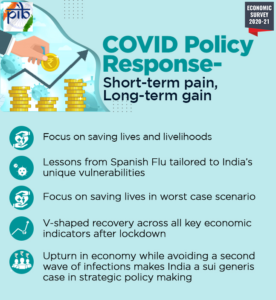- India focused on saving lives and livelihoods by its willingness to take short-term pain for long-term gain, at the onset of the COVID-19 pandemic
- Response stemmed from the humane principle that:
- Human lives lost cannot be brought back
- GDP growth will recover from the temporary shock caused by the pandemic
- An early, intense lockdown provided a win-win strategy to save lives, and preserve livelihoods via economic recovery in the medium to long-term

- Strategy also motivated by the Nobel-Prize winning research by Hansen & Sargent (2001): a policy focused on minimizing losses in a worst-case scenario when uncertainty is very high
- India’s strategy flattened the curve, pushed the peak to September, 2020
- After the September peak, India has been unique in experiencing declining daily cases despite increasing mobility
- V-shaped recovery, as seen in 7.5% decline in GDP in Q2 and recovery across all key economic indicators vis-à-vis the 23.9% GDP contraction in Q1
- COVID pandemic affected both demand and supply:
- India was the only country to announce structural reforms to expand supply in the medium-long term and avoid long-term damage to productive capacities
- Calibrated demand side policies to ensure that the accelerator is slowly pushed down only when the brakes on economic activities are being removed
- A public investment programme centered around the National Infrastructure Pipeline to accelerate the demand push and further the recovery
- Upturn in the economy, avoiding a second wave of infections – a sui generis case in strategic policy making amidst a once-in-a-century pandemic
India’s fight against COVID-19:
- Initial measures of lockdown, social distancing, travel advisories, practicing hand wash, wearing masks reduced the spread of the disease
- Country also acquired self-reliance in essential medicines, hand sanitizers, protective equipment including masks, PPE Kits, ventilators, COVID-19 testing and treatment facilities
- World’s largest COVID-19 vaccination drive commenced on 16th January, 2021 using two indigenously manufactured vaccines
Source: PIB & Economic Survey
















